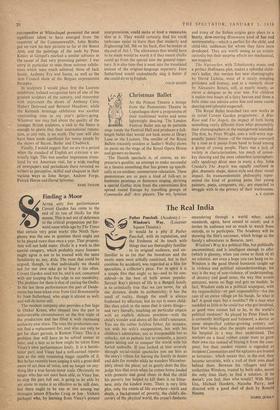Christmas Ballet
AT the Princes Theatre a troupe from the Pantomime Theatre in Copenhagen show a programme of their traditional works and some lightweight dancing. The London Festival Ballet sets up its portable stage inside the Festival Hall and produces a full- length ballet that would not look amiss at Drury Lane or the Lyceum. The smaller of the Royal Ballets (recently resident at Sadler's Wells) shows its paces on the stage of the Royal Opera House and garners no laurels.
The Danish spectacle is, of course, an im- presario's gamble; an attempt to make successful in a theatre something that has grown up specifi- cally as an outdoor, summertime relaxation. These pantomimes are as pure a kind of folk-art as bushman paintings or flamenco singing, deriving a special Gothic style from the conventions first spread round Europe by travelling groups of Commedia dell' Arse players. The wit, lyricism and irony of the Italian origins gave place to a - hearty, slow-moving Hanswurst kind of fun and sentimentality—which is perfect for the child, and child-like, audiences for whom they have been developed. They are worth seeing as an artistic curiosity but their surprise effects are mechanical, not magical.
The Nutcracker, with Tchaikovsky music and a perfect Hoffmann plot, makes a splendid child- ren's ballet; this version has new choreography by David Lichine, most of it nicely mingling prettiness and fantasy, and in a masterly decor by Alexandre Betiois, still, at nearly ninety, as clever a designer as he ever was. For children it makes two hours of a fairy heaven and those a little older can admire some fine and some comic dancing and splendid stagecraft.
The Royal Ballet launched two new works in its initial Covent Garden programme : A Blue Rose and The Angels, the impact of both being something vastly different from what presumably their choreographers or the management intended. The first, by Peter Wright, uses a well-worn sup- posedly 'poetic' theme—of the meanings conveyed by a rose as it passes from hand to hand among a group of young people. There was a lack of variety in characterisation, too much of minor- key dancing and the most colourless (atmospheri- cally speaking) decor seen in many a day. John Cranko's The Angels was equally confused in plot, dramatic shape, dance-style and sheer visual impact. Its transcendentalist philosophy repre- sented the kind of growing pains that young painters, poets, composers, etc., are expected to struggle with in the privacy of their. .workrooms.
A. V. COTON










































 Previous page
Previous page